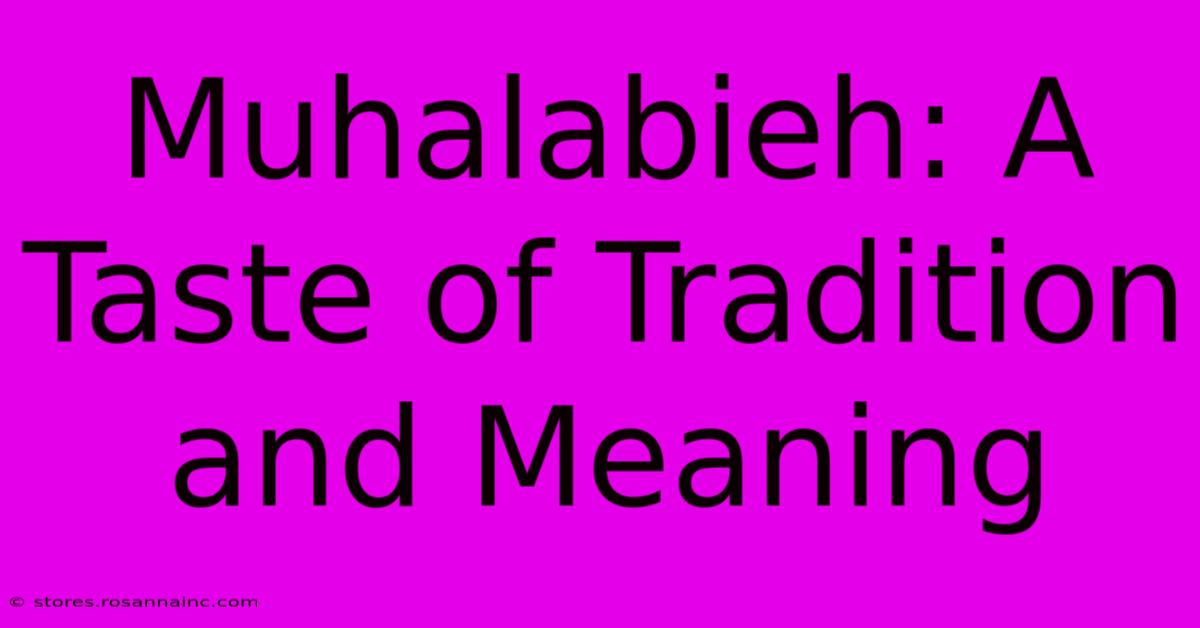Muhalabieh: A Taste Of Tradition And Meaning

Table of Contents
Muhalabieh: A Taste of Tradition and Meaning
Muhalabieh, a creamy, dreamy dessert, holds a special place in the hearts and kitchens of many Middle Eastern and Mediterranean cultures. More than just a sweet treat, it's a taste of tradition, a comforting familiarity passed down through generations, and often imbued with symbolic meaning, especially during celebrations. This article delves into the rich history, variations, and cultural significance of this beloved dessert.
A Journey Through Time: The History of Muhalabieh
The origins of muhalabieh are shrouded in some mystery, but its name hints at a possible connection to the ancient Arabic world. Some believe the name derives from "Mahalab," a type of cherry, though the dessert doesn't typically contain this fruit. Others posit a link to the Abbasid Caliphate period, where elaborate desserts were a hallmark of courtly life. Regardless of its precise origins, muhalabieh's presence in culinary traditions across the region speaks to its enduring appeal. Its simple yet elegant ingredients and preparation method have ensured its survival and evolution over centuries.
From Royal Tables to Modern Kitchens
Originally, muhalabieh likely featured ingredients reflecting the resources available to its creators: milk, sugar, and perhaps fragrant spices. Over time, regional variations emerged, incorporating local ingredients and preferences. This adaptability is one reason for muhalabieh's enduring popularity. While the base remains consistent, you'll find variations across different cultures, using ingredients like rosewater, orange blossom water, pistachios, almonds, and even coconut.
Muhalabieh: A Symphony of Flavors and Textures
The essence of muhalabieh lies in its remarkably smooth, creamy texture and subtly sweet flavor. The base is typically made with milk, thickened with cornstarch or rice flour, and sweetened with sugar. This simple combination forms a foundation upon which a multitude of flavor profiles can be built.
Regional Variations and Unique Twists
- Lebanese Muhalabieh: Often boasts a delicate rosewater flavor and is generously sprinkled with pistachios.
- Palestinian Muhalabieh: May include a hint of orange blossom water, lending a citrusy aroma.
- Turkish Muhalabieh: Sometimes incorporates a richer, creamier texture, achieved through the use of heavy cream or condensed milk.
- Egyptian Muhalabieh: May feature a topping of caramelized sugar, providing a delightful textural contrast.
These are just a few examples; the possibilities are truly endless. The beauty of muhalabieh lies in its versatility; it's a blank canvas for culinary creativity.
Muhalabieh: More Than Just Dessert – A Cultural Symbol
Beyond its delicious taste, muhalabieh holds cultural significance in many communities. It often features prominently at celebrations, festivities, and family gatherings. Its creamy, comforting nature makes it a fitting dessert for joyous occasions, representing sweetness and abundance.
Symbolic Significance and Traditions
In some cultures, muhalabieh is associated with good fortune, hospitality, and family unity. Sharing this dessert with loved ones is a gesture of warmth and connection. Its presence at weddings, birthdays, and religious holidays reinforces its status as more than just a dessert—it's a symbol of shared heritage and cultural identity.
Making Muhalabieh at Home: A Simple Guide
While you can certainly enjoy muhalabieh from various restaurants and bakeries, the process of making it at home is surprisingly straightforward. Numerous recipes are readily available online, catering to various skill levels and preferences. Making muhalabieh offers a rewarding experience, allowing you to personalize its flavor profile and connect with the traditions surrounding this cherished dessert.
Conclusion: A Taste of Heritage and Happiness
Muhalabieh is much more than just a dessert; it's a journey through time, a testament to culinary adaptability, and a symbol of cultural identity. Its simple yet satisfying nature makes it a cherished treat enjoyed by countless people across the globe. So, whether you're savoring its delicate flavors or preparing it in your own kitchen, embrace the rich history and cultural significance of this beloved dessert—a true taste of tradition and meaning.

Thank you for visiting our website wich cover about Muhalabieh: A Taste Of Tradition And Meaning. We hope the information provided has been useful to you. Feel free to contact us if you have any questions or need further assistance. See you next time and dont miss to bookmark.
Featured Posts
-
Live Kayo Sports Super Saturday Via Balboa
Feb 10, 2025
-
Skip The Hassle Smooth Travels Through El Salvador International Airport
Feb 10, 2025
-
Wheelchair Basketball Paralympic Glory Awaits
Feb 10, 2025
-
255 M Hurts Lives In 2000 Apartment
Feb 10, 2025
-
Blanchards Super Bowl Lix Pregame Show
Feb 10, 2025
